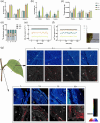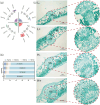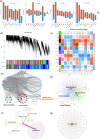Nitrogen reduces calcium availability by promoting oxalate biosynthesis in apple leaves
- PMID: 39372287
- PMCID: PMC11450213
- DOI: 10.1093/hr/uhae208
Nitrogen reduces calcium availability by promoting oxalate biosynthesis in apple leaves
Abstract
N and Ca are essential nutrients for apple growth and development. Studies have found that Ca content was not low under high N conditions but was poorly available. However, the underlying physiological mechanism through which N regulates Ca availability remains unclear. In this study, apple plants were supplied with N and Ca to analyse the content, in situ distribution, and forms of Ca using noninvasive micro-test technique, electron probe microanalysis, Fourier transform infrared spectroscopy, and transcriptome analysis. A potential interaction was observed between N and Ca in apple leaves. The application of high N and Ca concentration led to a CaOx content of 12.51 g/kg, representing 93.54% of the total Ca in the apple leaves. Electron probe microanalysis revealed that Ca deposited in the phloem primarily existed as CaOx rhombus-shaped crystals. Additionally, high N positively regulated oxalate accumulation in the leaves, increasing it by 40.79 times compared with low N concentration. Specifically, N induced oxalate synthesis in apple leaves by upregulating the MdICL, MdOXAC, and MdMDH genes, while simultaneously inhibiting degradation through downregulation of the MdAAE3 gene. Transcriptome and correlation analyses further confirmed oxaloacetate as the precursor for the synthesis of CaOx crystals in the apple leaves, which were produced via the 'photosynthesis/glycolysis -oxaloacetate -oxalate -CaOx' pathway. WGCNA identified potential regulators of the CaOx biosynthesis pathway triggered by N. Overall, the results provide insights into the regulation of Ca availability by N in apple leaves and support the development of Ca efficient cultivation technique.
© The Author(s) 2024. Published by Oxford University Press on behalf of Nanjing Agricultural University.
Conflict of interest statement
The authors declare no conflict of interest.
Figures








Similar articles
-
Traces of calcium oxalate biomineralization in fossil leaves from late Oligocene maar deposits from Germany.Sci Rep. 2022 Sep 24;12(1):15959. doi: 10.1038/s41598-022-20144-4. Sci Rep. 2022. PMID: 36153396 Free PMC article.
-
Visualisation of calcium oxalate crystal macropatterns in plant leaves using an improved fast preparation method.J Microsc. 2023 Jun;290(3):168-177. doi: 10.1111/jmi.13187. Epub 2023 Apr 21. J Microsc. 2023. PMID: 37060298
-
Heavy metal stress reduces the deposition of calcium oxalate crystals in leaves of Phaseolus vulgaris.J Plant Physiol. 2005 Oct;162(10):1183-7. doi: 10.1016/j.jplph.2005.03.002. J Plant Physiol. 2005. PMID: 16255177
-
Calcium Oxalate Crystals, the Plant 'Gemstones': Insights into Their Synthesis and Physiological Implications in Plants.Plant Cell Physiol. 2023 Oct 16;64(10):1124-1138. doi: 10.1093/pcp/pcad081. Plant Cell Physiol. 2023. PMID: 37498947 Review.
-
Calcium oxalate in plants: formation and function.Annu Rev Plant Biol. 2005;56:41-71. doi: 10.1146/annurev.arplant.56.032604.144106. Annu Rev Plant Biol. 2005. PMID: 15862089 Review.
References
-
- Wang WL, Cao ZM, Hou FR. et al. Quality maintenance mechanism of oxalic acid treatment in fresh-cut apple fruit during storage based on nontarget metabolomics analysis. Food Chem. 2024;436:137685. - PubMed
-
- Zhu ZL, Jia ZH, Peng L. et al. Life cycle assessment of conventional and organic apple production systems in China. J Clean Prod. 2018;201:156–68
-
- Freitas STD, Mitcham EJ. Mechanisms regulating apple cultivar susceptibility to bitter pit. Sci Hortic. 2015;186:54–60
LinkOut - more resources
Full Text Sources

